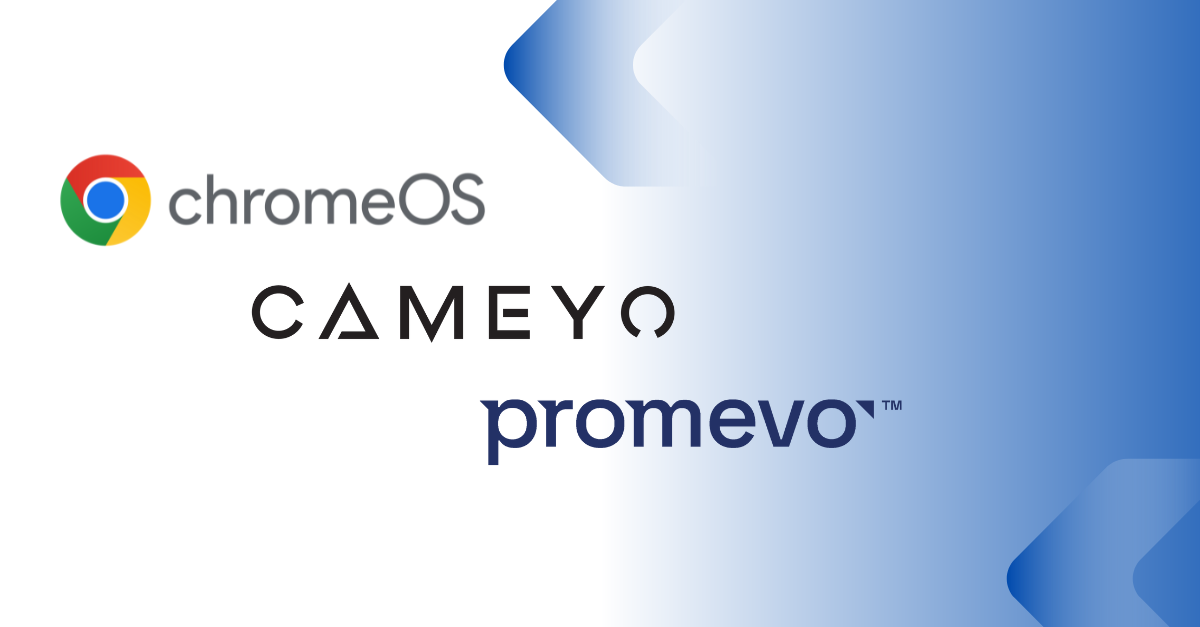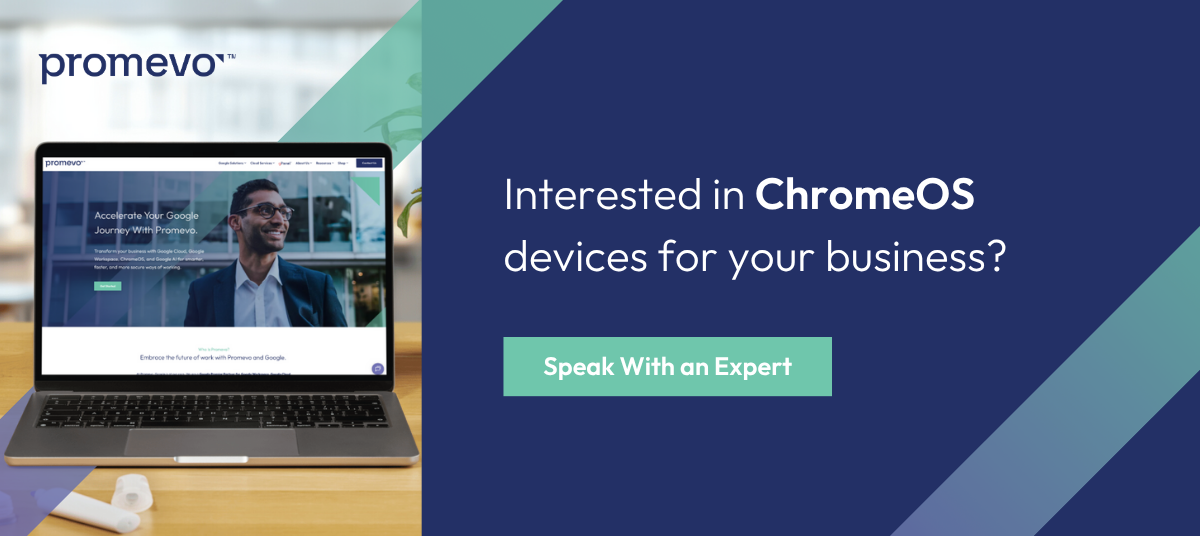On-Demand Webinar:
Delivering a Seamless, Productive App Experience on ChromeOS with Cameyo

View this on-demand webinar hosted by Google Partner Promevo featuring experts from Google and Cameyo.
If your organization plans to utilize Google (Google Cloud, ChromeOS, and/or Workspaces) as part of your secure hybrid work strategy, this session is for you.
This roundtable conversation features experts from the Google ChromeOS team, Google Partner Promevo, and Cameyo - the Chrome Enterprise Recommended Virtual App Delivery (VAD) provider.
This 30-minute session includes:
- An overview of how ChromeOS and Cameyo work together to deliver ultra-secure cloud desktops that enable your users to access all of their apps - including Windows, Linux, SaaS, and internal web apps - on ChromeOS devices just as if they were installed locally.
- A demo of Cameyo's platform showing you how you can quickly force install and pin apps to your users' ChromeOS devices via Google Admin Console in just minutes.
- A look at how Cameyo can be fully-hosted in Google Cloud or self-hosted in any multi-cloud, hybrid, or on-premises environment.
- A look at multiple ChromeOS & Cameyo case studies covering everything from Fortune 500s, to healthcare, to education orgs.
Interested in exploring virtual app delivery in your Chrome environment? Click here to start a trial with Cameyo.
Video Chapters
- 0:00 - Intro: Promevo - Who We Are
- 4:10 - Benefits to Deploying ChromeOS for your Business
- 6:00 - Security Features of ChromeOS
- 6:33 - Zero Touch Enrollment
- 12:00 - Virtual App Delivery (VAD) with Cameyo
- 13:48 - Why Cameyo?
- 17:25 - How Secure Cloud Tunneling Works
- 18:20 - Demo of Cameyo
- 25:05 - Additional Contact information for Promevo & Cameyo
- 25:44 - What is the difference between VDI & Virtual Desktops?
- 26:39 - Can you touch more on File Integration & Drive (especially for Word)
- 28:44 - Can the ChromeOS File Manager know to open a Cameyo App?
- 29:15 - Are there any requirements for running this on a Chromebook?
- 29:49 - What can we expect with locally attached devices interacting with Cameyo Published Apps?
- 30:40 - For Hosting - do you offer BAA (Hippa)?
- 30:50 - What is the protocol used for the browser RDP H264?
Transcript
Hailee Zapata:
Welcome to our webinar on delivering a seamless productive app experience on ChromeOS with Cameyo!
We are excited to have representation from both Cameyo and ChromeOS with us today. Over the next thirty minutes, we're going to explore how ChromeOS and Cameyo work together. We'll complete a live demo of Cameyo's platform, which also demonstrates how Cameyo can be fully hosted in Google Cloud or self-hosted on a multi-cloud, hybrid, or on-premises environment. At the end, we'll have a Q&A.
I'd like to introduce myself. I'm Hailee Zapata, your webinar host and the Alliance Marketing Manager at Promevo. We specialize in ChromeOS, Google Cloud, Google Workspace, and our own Workspace management tool, gPanel.
So, Promevo is proud to have two great partners here today. Let me introduce our presenters: Eric Johnson, our Account Executive at Cameyo, and Sandeep Gupta, Business Development and Go-to-Market Lead at ChromeOS with Google.
Alright, Sandeep, take it away.
Sandeep Gupta:
Thank you, Hailee, for the introduction. I'm Sandeep Gupta, the Chrome Enterprise Lead for Business Development and Go-to-Market focused on virtual apps.
Looking at the poll responses, it's great to see Chrome's usage and adoption percentages. We'll dive into that shortly, but first, I'll give a quick overview of ChromeOS and our partnership with Cameyo.
These two solutions complement each other seamlessly after years of collaboration. Legacy endpoints have caused issues, especially with the shift to remote work.
ChromeOS offers a secure, nimble alternative. It's inherently safe and offers flexibility, with all critical apps delivered from the cloud.
Additionally, it's cost-effective and eco-friendly. ChromeOS puts you in control with built-in proactive security, granular policy controls, automatic updates, and more.
Zero-touch enrollment simplifies device management, and our device ecosystem offers various form factors. Employees can work offline with access to Google Play Store apps and local files.
ChromeOS is designed to optimize costs and energy consumption, saving up to $482 per device per year. It's also eco-friendly, using less energy and sustainable materials. Now, let's see how we enable ultra-secure cloud desktops with Cameyo for virtual app delivery.
Eric, over to you.
Eric Johnson:
Thank you, Sandeep, for laying that foundation. What's really cool about being part of Cameyo is that my role as an account executive is to help customers realize the value of their Chrome implementation and Chromebooks in their infrastructure.
Here at Cameyo, we focus on Virtual Application Delivery, which is an evolution of what we've historically done with EDI and VDI.
VDI allows non-cloud-native delivery of Windows desktops, and Cameyo takes it to the next level by offering cloud-native virtual application delivery. You can host in your environment or Cameyo's environment and deliver to any device, which is the real power of Cameyo.
Let's go over our four pillars. First, Cameyo is simple. You can publish an application through Cameyo in just a few minutes, making the implementation of your software easy.
Security is a priority. Cameyo eliminates the need for a desktop, VPN, and open firewall and server ports, enhancing your security.
It's incredibly cost-effective, with customers saving around 70% when converting from legacy VDI.
Lastly, Cameyo offers flexibility, allowing you to run any application on any device. We integrate with your SSO providers, and databases, and can even help with legacy on-prem applications.
Transparency is a key focus at Cameyo. We strive to make the user experience seamless and transparent without introducing unnecessary complexity. We also integrate well with Chrome, focusing on PWAs. With Cameyo, you can push those PWAs to Windows devices and make the transition to Chrome easy for users.
Now, let's talk about architecture. The endpoint device requests access to the application, and a Cameyo server is assigned to the task. A secure handshake takes place in Cameyo's secure cloud tunneling service, and the application is presented to the end user's device fully encapsulated in HTML5.
I'll now demonstrate how to publish an application in Cameyo.
This is the Cameyo interface, and it's incredibly elegant. I'll show you how quick and easy it is to publish an application.
First, you bring your installer files or download them if you don't have them. Install the application on the server, and you're done with the first two steps. Then, go to the Publisher Apps window, where you can see the apps you've recently installed. Click to publish them, and it's done. In a minute, you have your application available.
You can also push it out as a PWA for an even better user experience. Users can access the application with a simple link. We offer SSO integration for even smoother access. The application runs in the browser but feels like a local installation. It supports various features, including keyboard pass-through, native file dialog replacement, and printing.
We replace the native file dialog with a direct connection to your Google Drive, offering a seamless file-handling experience. Printing works flawlessly, and you can switch between multiple applications running through Cameyo. It's all about providing a native experience on Chromebooks.
We offer additional features like SSO integration, Google Drive connection, and customization with your company logo. Our dashboard provides insights into your organization's usage.
In conclusion, Cameyo is an elegant and straightforward solution that challenges the paradigm of needing a desktop for Windows applications. You can run these applications effectively on Chromebooks, and we're here to partner with Google and Promevo to help you package this solution.
We offer a free trial of Cameyo, so contact your Promevo sales rep to get started.
Now, let's open the floor to questions.
Hailee Zapata:
Wonderful, thank you, Sandeep and Eric. Eric, your live demo was excellent.
Before we dive into the questions, I'd like to draw your attention to the links on this page. You can explore the websites of both Promevo and Cameyo, along with some related content that you'll receive links to in an email.
Cameyo conducted a joint research analysis with ESG and IDC, and there's a wealth of valuable content in there, so make sure to check it out.
We'd also like to announce that our next webinar will take place on July 26th, focusing on BeyondCorp Enterprise. You'll find the registration link in the email you receive. Now, let's get to some questions.
Eric, this one's for you. What's the difference between VDI and virtual desktops?
Eric Johnson:
Sure, great question. VDI, or Virtual Desktop Infrastructure, traditionally refers to the practice of running a desktop operating system, such as Windows, on a server in a data center and then delivering that desktop experience to end-user devices over the network. It provides a one-to-one virtual desktop experience, where each user typically gets their own isolated virtual machine running a full desktop OS.
Virtual desktops, on the other hand, are a broader term that encompasses various approaches to providing desktop-like experiences to end-users. This can include VDI, but it also includes other methods like Desktop as a Service (DaaS), which may involve more cloud-based solutions. VDI is a specific subset of virtual desktops, but the terms are often used interchangeably.
With Cameyo, we take the concept of virtual application delivery to a new level, offering cloud-native, flexible hosting and simplified application publishing, making it easier to deliver applications to users without the need for traditional desktop environments.
Hailee Zapata:
Thanks, Eric. That clarifies it.
Now, can you provide more information about file integration and working with documents like Word?
Eric Johnson:
Absolutely. Cameyo offers robust file integration capabilities. It allows users to seamlessly work with files and documents. For example, you can easily designate how different file types should be handled, such as specifying which applications should open certain file formats.
This can work for applications like Microsoft Word, where Word documents can be opened within Cameyo, edited, and saved directly to your Google Drive or other cloud storage solutions, just as if you were using a locally installed version of Word.
The integration with cloud storage and document management systems is a key feature, and it provides a highly flexible and efficient workflow for working with files within Cameyo.
Hailee Zapata:
Great, thanks for explaining that. Next question, how secure is Cameyo, and what's your approach to security?
Eric Johnson:
Security is a top priority for Cameyo. Our approach to security is unique and highly effective. We eliminate the need for traditional desktop environments, VPNs, and other common attack vectors. By delivering applications through a browser-based experience, we significantly reduce the attack surface, making it more difficult for malicious actors to gain access to your infrastructure.
Cameyo also uses secure encryption protocols to protect data in transit. The RDP (Remote Desktop Protocol) is used for remote desktop sessions and is encapsulated securely within HTML5. This encryption ensures that data is protected during transmission.
Our approach to security is innovative and aims to eliminate known vulnerabilities while providing a seamless application delivery experience. Our CTO humorously describes Cameyo as a security product packaged within an application delivery product, highlighting the robust security features of our solution.
Hailee Zapata:
Thank you for emphasizing the security aspect. Now, can the ChromeOS file manager recognize and open Cameyo apps?
Eric Johnson:
Yes, Cameyo's integration is designed to be seamless, making it appear as though the applications are locally installed on the user's device.
When you use Cameyo to open an application, it integrates well with the ChromeOS file manager, and users can interact with the Cameyo-delivered applications as if they were native to the Chromebook. This ensures that the user experience is familiar and intuitive.
Hailee Zapata:
That's convenient and user-friendly. Here's another question: Can Cameyo applications work with peripheral devices, and if so, how does it handle them?
Eric Johnson:
Cameyo is designed to work with a wide range of peripheral devices. The applications delivered through Cameyo can interact with peripheral devices in much the same way as if they were locally installed. This includes support for printers, scanners, and other common peripherals.
Cameyo's HTML5 player and the use of the Remote Desktop Protocol (RDP) help ensure that peripheral devices can work seamlessly with the delivered applications. In some cases, there may be specific configurations needed for certain peripherals, but in general, Cameyo is designed to provide a smooth experience with peripheral devices.
Hailee Zapata:
It's great to know that it supports a wide range of peripherals.
Here's another question: Does Cameyo offer BAA (Business Associate Agreement) compliance, such as HIPAA?
Eric Johnson:
Yes, Cameyo can be configured to be HIPAA-compliant. HIPAA (Health Insurance Portability and Accountability Act) compliance is important for organizations handling sensitive healthcare information, and Cameyo can be adapted to meet these requirements.
If your organization needs to ensure HIPAA compliance, Cameyo can be configured to provide the necessary security and controls to support your compliance efforts.
Hailee Zapata:
Excellent, that's essential for healthcare organizations. Here's one more question: What protocol does Cameyo use for delivering applications through the browser, such as RDP or h.264?
Eric Johnson:
Cameyo primarily uses the RDP (Remote Desktop Protocol) for delivering applications through the browser. This protocol ensures secure and efficient remote access to applications while maintaining a responsive and user-friendly experience.
RDP is well-suited for delivering Windows applications through the browser, and it's the foundation of Cameyo's application delivery approach.
Hailee Zapata:
Thank you for explaining that.
Alright, we've reached the end of our time, and we've covered most of the questions. I want to express my appreciation to Eric and Sandeep for providing valuable insights into Cameyo. Your live demo and explanations were fantastic.
Thank you all for joining us today. Please watch out for the email, which will include the webinar recording and links to related content. If you have any additional questions or if we didn't address a specific question, we'll follow up with you personally to provide the answers.
Also, we'll create a blog post with the questions and answers for your reference. Keep an eye out for that. Have a wonderful day, everyone!
Presenters
Choose your Google Workspace edition. Try it free for 14 days.
- Gmail
- Drive
- Meet
- Calendar
- Chat
- Docs
- Sheets
- Slides
- Keep
- Sites
- Forms
 Custom and secure business email
Custom and secure business email
 100 participant video meetings
100 participant video meetings
 30 GB cloud storage per user
30 GB cloud storage per user
 Security and management controls
Security and management controls
 Standard Support
Standard Support
 Custom and secure business email
Custom and secure business email
 150 participant video meetings + recordings
150 participant video meetings + recordings
 2 TB cloud storage per user
2 TB cloud storage per user
 Security and management controls
Security and management controls
 Standard Support (paid upgrade to Enhance Support)
Standard Support (paid upgrade to Enhance Support)
 Custom and secure business email + eDiscovery, retention
Custom and secure business email + eDiscovery, retention
 250 participant video meetings + recordings, attendance tracking
250 participant video meetings + recordings, attendance tracking
 5 TB cloud storage per user
5 TB cloud storage per user
 Enhanced security and management controls, including Vault and advanced endpoint management
Enhanced security and management controls, including Vault and advanced endpoint management
 Standard Support (paid upgrade to Enhance Support)
Standard Support (paid upgrade to Enhance Support)
 Custom and secure business email + eDiscovery, retention, S/MIME encryption
Custom and secure business email + eDiscovery, retention, S/MIME encryption
 250 participant video meetings + recordings, attendance tracking noise cancellation, in-domain live streaming
250 participant video meetings + recordings, attendance tracking noise cancellation, in-domain live streaming
 As much storage as you need
As much storage as you need
 Advanced security and management and compliance controls, including Vault, DLP, data regions, and enterprise endpoint management
Advanced security and management and compliance controls, including Vault, DLP, data regions, and enterprise endpoint management
 Enhanced Support (paid upgrade to Premium Support)
Enhanced Support (paid upgrade to Premium Support)
Business Starter, Business Standard, and Business Plus plans can be purchased for a maximum of 300 users. There is no minimum or maximum user limit for Enterprise plans.
Contact Sales


.png)

